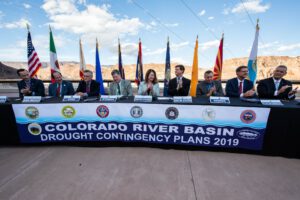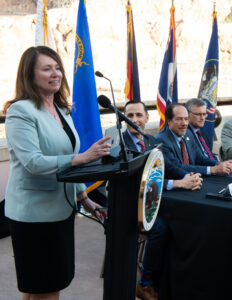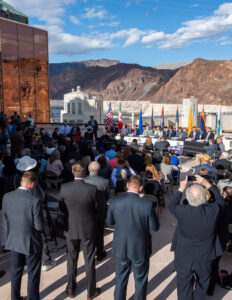On May 20, 2019, representatives of the U.S. Department of the Interior, the Bureau of Reclamation, key water districts, and the seven Colorado River basin states gathered at the top of Hoover Dam to sign the Drought Contingency Plan (DCP), an ambitious agreement designed to reduce risk on the Colorado River and sustain the river system into the future. As the federal agency responsible for water management in the West, Reclamation played a pivotal role in helping to facilitate the development and successful passage of the DCP at the federal level. In this interview, Brenda Burman, the commissioner of the Bureau of Reclamation, speaks with Municipal Water Leader Editor-in-Chief Kris Polly about the process of developing the DCP and its promise for the future.
Kris Polly: Please explain the DCP and its significance.

Brenda Burman: The finalization of the DCP for the upper and lower basin states of the Colorado River is an incredible feat. The DCP isn’t just one agreement; it is a multifaceted set of actions and agreements by those seven states and Mexico to move forward to address significant risks on the Colorado River system. The states have come together with Mexico to immediately and simultaneously save water in both countries. They are doing that because the Colorado River is experiencing a historic drought. The 19-year period from 2000 to 2018 was the driest in our recorded history, which goes back over 100 years. It’s also one of the driest periods in the paleo record, looking back over 1,200 years. Working with the states, we all recognized that there was too high a risk of us losing the system and of there being severe repercussions in the Southwest if actions were not taken. The basin states came together with the U.S. Department of the Interior to design voluntary actions that could reduce this risk and allow everyone to move forward with coordinated and dependable actions to protect the system.
Kris Polly: With the passage of the DCP legislation, what are the next steps?
Brenda Burman: It took us several years of negotiations with Mexico and with the states to get this far, and it wasn’t easy. The states and major water users had to be able to go home and argue that there should be more water savings and more water maintained behind Lake Powell and Lake Mead. That may turn out to have been easy compared to implementation, which is what we are working on now. The DCP is designed to be in place through 2026. It will work as an overlay to the 2007 guidelines for the operation of Lake Powell and Lake Mead, which will also extend to 2026. Our main goal, starting the day after the agreement was signed on May 20, is to move forward with implementation. That means that we are working with Mexico to put together the implementation details of its scarcity plan, which will allow it to work simultaneously with the United States to save water behind Lake Mead. Implementation is different for each state and each basin. The upper basin states will be moving forward with implementing different methods of saving water behind Lake Powell. They’re going to have to work both individually and with each other to figure out how to make that happen. In the lower basin, the situations of Arizona, California, and Nevada are very different. Those states have worked hard to make sure that they’re ready to make specific and certain contributions of water to keep Lakes Mead and Powell out of crisis.

Kris Polly: What must happen on the Colorado River system to ensure sustainability into the future?
Brenda Burman: The DCP is an incremental step in a long line of impressive steps that the basin states, key water districts, the Department of the Interior, and the Republic of Mexico have taken to address the problems and challenges on the river. Those steps go all the way back to the 2001 Interim Surplus Guidelines, the 2007 Coordinated Operations and Shortage Guidelines for Lake Mead and Lake Powell, and numerous historic agreements with Mexico. The DCP is yet another step that the basin states, water users, and the two countries are taking together to address the question of the sustainability of the Colorado River.
Kris Polly: What is your message to all Colorado River water users?
Brenda Burman: All the states, water districts, tribes, and NGOs that have come together should be commended
for finding a path forward. This was not easy. It took real creativity. It took real sacrifice. In return, we’re creating a lot of flexibility on the river to allow people more incentives to go home and save more water. To the basin states and
to all the parties that were essential to protecting the water supplies of over 40 million people, I would say, “Good job.”
Kris Polly: What is your message to Congress now that the DCP has been passed?
Brenda Burman: The DCP took several years to come together. When it did, it occurred with the support of the states, major water users, tribes, NGOs, and other partners. They brought this legislation to their delegations in Congress. It was bipartisan and it stretched across state lines and across the divide between agricultural and urban interests. Everybody came together to make this work. I commend the swift work of Congress and the swift work of President Trump in signing this legislation.
Kris Polly: Is there anything else that you’d like to address?

Brenda Burman: Looking back at the process, I would say that deadlines matter. My first action as commissioner of the Bureau of Reclamation was to travel out to the Colorado River Water Users Association meeting in Nevada in December 2017. I called on the basin states to finish their work to address the crisis on the Colorado River. We set timelines and we moved forward. I think that was important. The federal government was not going to sit back and let the risk on the Colorado River become too high. The Colorado River is a special place, both legally and practically, in that the secretary of the interior has the ability to step in and make things work if they have to— particularly in the lower basin. In this case, the secretary Commissioner Brenda Burman speaks at the DCP signing ceremony. didn’t have to, because the basin states, tribes, key water districts, and others came together to protect the system. We have a long history of cooperation on the river, but it’s important to know that the federal government is not going to let the system fall into crisis. A lot of voluntary steps are going to need to be taken. Implementation is not going to be easy, but we’re going to learn a lot over the next 7 years, and we’re going to use all of that learning and information to help us determine what our next steps to manage the Colorado River should be based on our experience implementing the DCP.
Brenda Burman is the commissioner of the Bureau of Reclamation. For more information about Reclamation,
visit www.usbr.gov.
